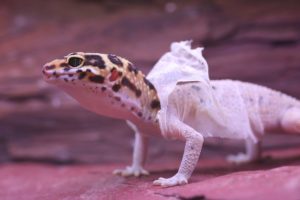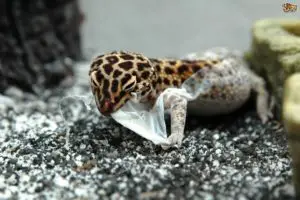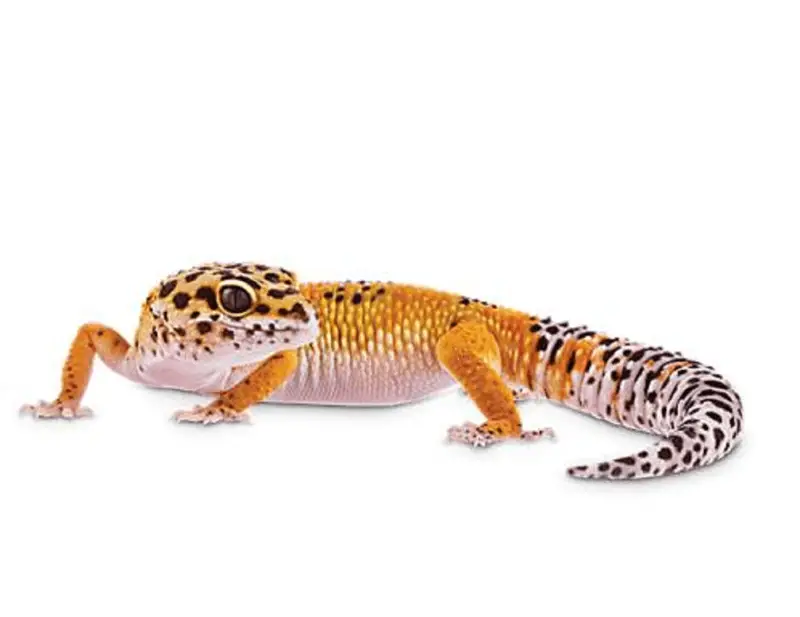The leopard gecko is a lizard that originates from parts of Asia, Afghanistan and India. Its’ scientific name, macula, describes the spotted markings on the lizard’s skin. The average lifespan of a leopard gecko is 20 years. It can also grow up to 25 cm long. Unlike other reptiles of its’ kind, they are unable to climb up vertical surfaces, such as walls. Why is your leopard gecko shedding?
These make for good pets because of their docile disposition. With adult supervision, even children can feel the joy that comes from playing with one. Their diet is also straightforward, as they are insectivores. Although if you would like to know more about the best leopard gecko diet read this article.
Caring for a leopard gecko is a rewarding experience. As a first-time pet owner, you may have concerns about your animal. For instance, have you noticed your leopard gecko beginning to shed? Why is that so? What happens during the process? And what can you do to help? All these questions will be addressed throughout the article about leopard gecko shedding.
Do leopard geckos shed?
First off lets answer this question to set us off on the right track as I have seen some false information dotted about on the internet about leopard gecko skin shedding.
Does a leopard gecko shed its skin? Yes a leopard gecko does shed its skin and for a new owner this can look a bit shocking at first. Do not worry though shedding is a natural process for leopard geckos and often quite a regular occurrence, especially in the juvenile stages of its life.
There are ways that you can help your leopard gecko when it is in a leopard gecko shedding phase so read on to find out more information.
Why Do Leopard Geckos Shed Their Skin?
Reasons for shedding skin
Think of it this way. A growing child will get bigger and taller. The clothing that may have fit them at the outset no longer does. It has become too tight or too small. They’ve outgrown their clothes. In a similar way, the leopard gecko also grows. When its’ outer skin no longer accommodates their body, they will shed.
Another reason why leopard geckos shed their skin is because of aging. Old skin needs to be regenerated into new skin. Humans go through this, as well, but in a less obvious and more continuous manner than the lizard. That’s because we shed in barely noticeable patches, whereas your pet does so all at once.
What happens to the skin once it has shed?

When humans grow we buy new clothes. When a leopard gecko grows its changes its skin.
After your pet has finished leopard gecko shedding, you might notice it doing something seemingly strange. If it is eating its’ shed skin, don’t get grossed out. This is perfectly normal for a healthy leopard gecko. You see, the leopard gecko shedding process is a lot of work for them. Their skin is full of minerals that are beneficial to their nutrition. The ingested nutrients help make for strong, new skin.
Eating their shed skin is a survival instinct that is deeply rooted in your animal. In the wild, leaving traces of shed skin around notifies predators that they are there. By ingesting it, they are masking their scent as potential prey.
Leopard geckos are clean animals, too. Sometimes, they will clean up their shed skin to keep a tidy environment clean.
Is Shedding Uncomfortable for Leopard Geckos?
Fasting
Leopard gecko shedding can be a stressful time for your pet because of the discomfort it may experience. The process lasts about 24 hours. Moreover, the leopard gecko tends not to eat the day before the shedding begins. Being hungry isn’t very pleasant, especially over a course of 48 hours. Make sure you give them the right diet.
Complications
Other factors may also come into play when leopard gecko shedding. These may seem minor at first glance, but if left untreated, can become problematic for your pet in the long run. It can even go as far as diminishing their quality of life and reducing their life expectancy.
The first problem will arise when there is an accumulation of excess skin around the toe area. This can become a more serious issue if it cuts off circulation from the blood flow. This may lead to a loss in the leopard gecko’s extremities.
The second problem can occur when the lizard is unable to shed off the old skin in its’ entirety. A tell-tale sign of this dilemma is the presence of patches of unshed skin on the reptile’s body.
How Often Do Leopard Geckos Shed Their Skin?
The frequency that a leopard gecko will shed its’ skin has a lot to do with age. It will also depend on the rate at which it grows. Young lizards are constantly growing, so they will shed more often. This can happen about once a week. It is difficult, however, to determine the exact frequency or cycle of their shedding. That’s because no two lizards are exactly alike. For mature, adult lizards, you can expect them to shed about every two weeks.
The best way to keep track of your pet’s growth rate is by recording things like its’ weight and length.
How to Know When a Leopard Gecko Will Shed
A pet owner will know when their leopard gecko is about to shed just by looking at it. Your pet’s skin colour will appear duller. The leopard gecko shedding process is in its’ early stages when you see skin turn white. As it does so, it will begin to detach itself from the lizard’s body.
How to Help a Leopard Gecko That is Shedding
Humidity

Generally the leopard gecko will know what to do when it is time to shed
A humid environment helps the leopard gecko have an easier time shedding. To ensure a stable humidity level of 20% to 40%, you may want to consider getting a hygrometer. It works like a thermometer but reads the level of humidity in your pet’s enclosure. If it is too low, you can add moss or a water dish in the vivarium.
During shedding, the reptile will want to hide. Some pet owners have found it helpful to include a plastic container for them to run into. This provides for them a moist shelter. Cut a hole in the temperature that is large enough for your lizard to fit inside, but small enough to not let light penetrate through.
A bath
A warm bath may be just what your leopard gecko needs to shed that excess skin. The water should be lukewarm and in a shallow container. You want the lizard to be able to move around a little bit, not drown.
Massage
To aid your pet in shedding its’ skin, you can also try rubbing it gently. This can be done with the help of a cotton ball. Apply some warm water to it and gently massage the toes or wherever skin isn’t shedding.
Conclusion
The leopard gecko is a pleasant animal to own as a pet. It is easy to take care of. The reptile also has the reputation of having a docile nature. One thing that will frequently occur throughout a lizard’s lifetime is shedding. There are many reasons for this, such as the replacement of old skin for new skin, as well as the reptile outgrowing its’ skin. This can happen anywhere between once a week for juvenile lizards to every two weeks for adults.
If you do decide to give your leopard gecko a bath or massage be careful not to stress it as this could lead to a bite.
You can tell when a leopard gecko is about to shed when their appearance gets duller. Their skin turns white in the places it has detached itself from the body.
If you see your pet ingesting its’ skin after shedding, there is no cause for concern. It is your animal’s way of getting their mineral intake. It also traces its’ roots from a survival instinct of protecting themselves from predators.
As this can be an uncomfortable time for your pet, you may want to help facilitate the process. You can do so by making their environment have more humidity. This can be done by increasing moisture in the vivarium. You may also want to treat your pet to a spa day with a warm bath, a spa and a gentle massage.
Too read more helpful leopard gecko guides here on Super Crazy Pets check out this link.
